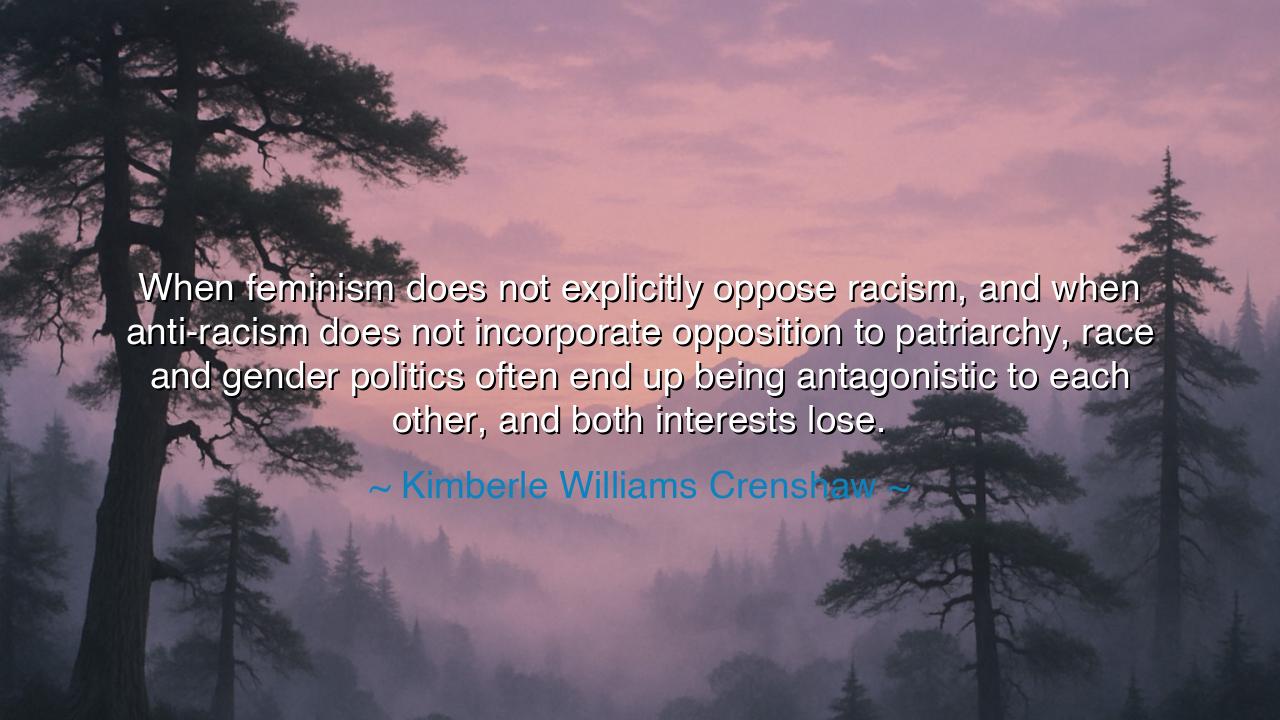
When feminism does not explicitly oppose racism, and when
When feminism does not explicitly oppose racism, and when anti-racism does not incorporate opposition to patriarchy, race and gender politics often end up being antagonistic to each other, and both interests lose.






Hear, O seekers of justice, the wisdom of Kimberlé Williams Crenshaw, mother of the word intersectionality, who declared: “When feminism does not explicitly oppose racism, and when anti-racism does not incorporate opposition to patriarchy, race and gender politics often end up being antagonistic to each other, and both interests lose.” In this saying she unveils a truth often forgotten—that struggles for freedom, if they do not walk hand in hand, can stumble into division and defeat.
For feminism, when it forgets the burdens of race, risks becoming a movement for only a portion of women—those who already stand closer to privilege. And anti-racism, if it ignores patriarchy, may liberate men of color while leaving their sisters still in chains. Thus, Crenshaw warns that justice cannot be partial. To fight one system of oppression while excusing another is to build freedom with cracks in its foundation, leaving all vulnerable to collapse.
History itself bears witness. In the women’s suffrage movement of the 19th century, leaders like Elizabeth Cady Stanton and Susan B. Anthony often chose to distance themselves from the fight for Black equality, fearing it would weaken their cause. In doing so, they alienated women of color, whose voices were silenced in the very movement that promised liberation. The result was division, mistrust, and the slowing of progress for both race and gender justice.
So too in the civil rights struggles of the 20th century, women of color often found themselves pushed to the margins, their leadership overlooked, their struggles minimized. Yet figures like Ella Baker, Fannie Lou Hamer, and Angela Davis rose up, embodying the truth that patriarchy and racism are intertwined, and that true liberation demands confronting both together. Their lives became living testimony to the vision Crenshaw would later name.
Therefore, let this wisdom endure: the fight against oppression must be whole. Feminism must confront racism; anti-racism must resist patriarchy. Only when movements unite, when they refuse to pit one struggle against another, will freedom be lasting and complete. Crenshaw’s words shine as both warning and guide, teaching future generations that the destiny of justice lies not in division, but in solidarity.






MTnguyen minh thu
I find Crenshaw’s point about the antagonism between race and gender politics quite thought-provoking. If we continue to treat feminism and anti-racism as separate, it’s easy for both movements to lose momentum and impact. What would it take to make sure that feminist and anti-racist movements not only coexist but also work collaboratively? How can we ensure that all marginalized groups are at the forefront of these conversations?
SDSon Dinhthe
Kimberlé Crenshaw’s quote strikes at the heart of intersectionality. If feminism and anti-racism aren’t working together, it’s clear that marginalized people, especially women of color, will bear the brunt of this division. How do we create a framework for activism that truly understands the intersection of race and gender, rather than treating them as isolated issues? What are the consequences if we continue to overlook these overlapping struggles?
HHHong Ha
Crenshaw’s statement brings up an important concern about the division between race and gender politics. If feminism ignores racism, and anti-racism ignores patriarchy, the very people who are most affected by both will lose out. How can we ensure that activists and advocates address both issues simultaneously? How do we bridge the gap between these movements without diminishing the impact of either one?
TMThu Le thi mai
Kimberlé Crenshaw’s quote highlights the critical intersection between feminism and anti-racism, and it’s a powerful reminder that these movements must support each other. Too often, feminism and anti-racism are treated as separate issues, even though they are deeply interconnected. How can we build movements that are more inclusive, where both race and gender are prioritized equally? Is it possible to move beyond the silos and create a truly unified approach to social justice?